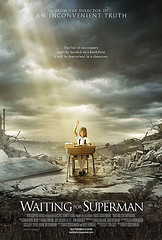One of the topics I get asked about most on MBA Mondays is "options." But options are only one form of employee equity. I am going to do a series of posts on this topic over the next month of MBA Mondays. I will start by laying out the logic for employee equity, going over some target ownership levels, and describing the various securities you can use to issue employee equity.
One of the defining characteristics of startup culture is employee ownership. Many large companies provide employee ownership so this is not unique to startup culture. But when you join a startup, you have the expectation of getting some ownership in the company and if the company is successful and is sold or taken public, that you will share in the gains that result.
Employee ownership is such an important part of startup culture. It reinforces that everyone is on the team, everyone is sharing in the gains, and everyone is a shareholder. I can't think of a company that has come to pitch us that has not had an employee equity plan. And I can't think of a term sheet that we have issued that didn't have a specific provision for employee equity. It is simply a fundamental part of the startup game.
While employee equity is "standard" in the startup business, the levels of employee ownership vary quite a bit from company to company. There are a variety of reasons. Geography matters. Employee ownership levels are higher in well developed startup cultures like the bay area, boston, and NYC. They are lower in less developed startup communities. Engineering heavy startups will tend to have higher levels of employee ownership than services and media companies. I am not suggesting that is right or fair, but it is what I have seen. And if the founders are the top managers in a company, the level of "non founder employee ownership" will be lower. If the founders are largely gone from a company, the levels of "non founder employee ownership" will be higher.
If the founders are the top managers in the company, then the typical "non founder employee ownership" will tend to be between 10% and 20%. If the founders have largely left the company, then "non founder employee ownership" will be closer to 20% and could be a bit higher. I like the 20% number as a target if for no other reason than it maps well to the VC business. The people providing the "sweat equity" typcally get 20% of the gains in our business (at USV we get 20%) and they should get at least that in the companies we back. I say "at least" because the founders are often still providing "sweat equity" and they can own much more than 20%.
There are four primary ways to issue employee equity in startups:
– Founder stock. This is the stock that founders issue to themselves when they form the company. It can also include stock issued to early team members. Founder stock has special vesting provisions among the founders so that one or more of them doesn't leave early and keep all of their stock. Those vesting provisions are extended to the investors once capital is invested in the business. Founder stock will typically be common stock and it will be owned by the founders subject to vesting provisions.
– Restricted stock. This is common stock that is issued to either early employees or top executives that are hired into the company fairly early in a company's life. Restricted stock will have vesting provisions that are identical to standard employee option plans (typcially four years but sometimes three years). The difference between restricted stock and options is that the employee owns the shares from the day of issuance and can get capital gains treatment on the sale of the stock if it is held for one year or more. But issuing restricted stock to an employee triggers immediate taxable income to the recipient so it can be very expensive to the recipient and therefore it is only done very early when the stock is not worth much or when a senior executive is hired who can handle the tax issues.
– Options. This is by far the most common form of employee equity issued in startup companies. The stock option is a right issued to an employee to purchase common stock at some point in the future at a set price. The "set price" is called the "strike price." I am going to do at least one and probably several ful MBA Mondays posts on options so I am not going to say much more now.
– Restricted Stock Units. Knows as RSUs, these securities are relatively new in the startup business. They were created to fix issues with options and restricted stock and have characteristics of both. A RSU is a promise to issue common stock once the vesting provisions have been satisfied. The vesting provisions can include a liquidity event. So when you are getting an RSU, you are getting something that feels like an option but there is no strike price. When you get the shares, you will own them outright. But you might not get them for a while.
I will end this post by imploring all of you entrepreneurs to hire an experienced startup lawyer. Employee equity issues are tricky. You can and will make a bunch of expensive mistakes with employee equity unless you have the right counsel. There are plenty of law firms and lawyers who specialize in startups and you should have one of them at your side when you are setting up your company and throughout its life. That is true for a lot of reasons, but employee equity is one of the most important ones.








